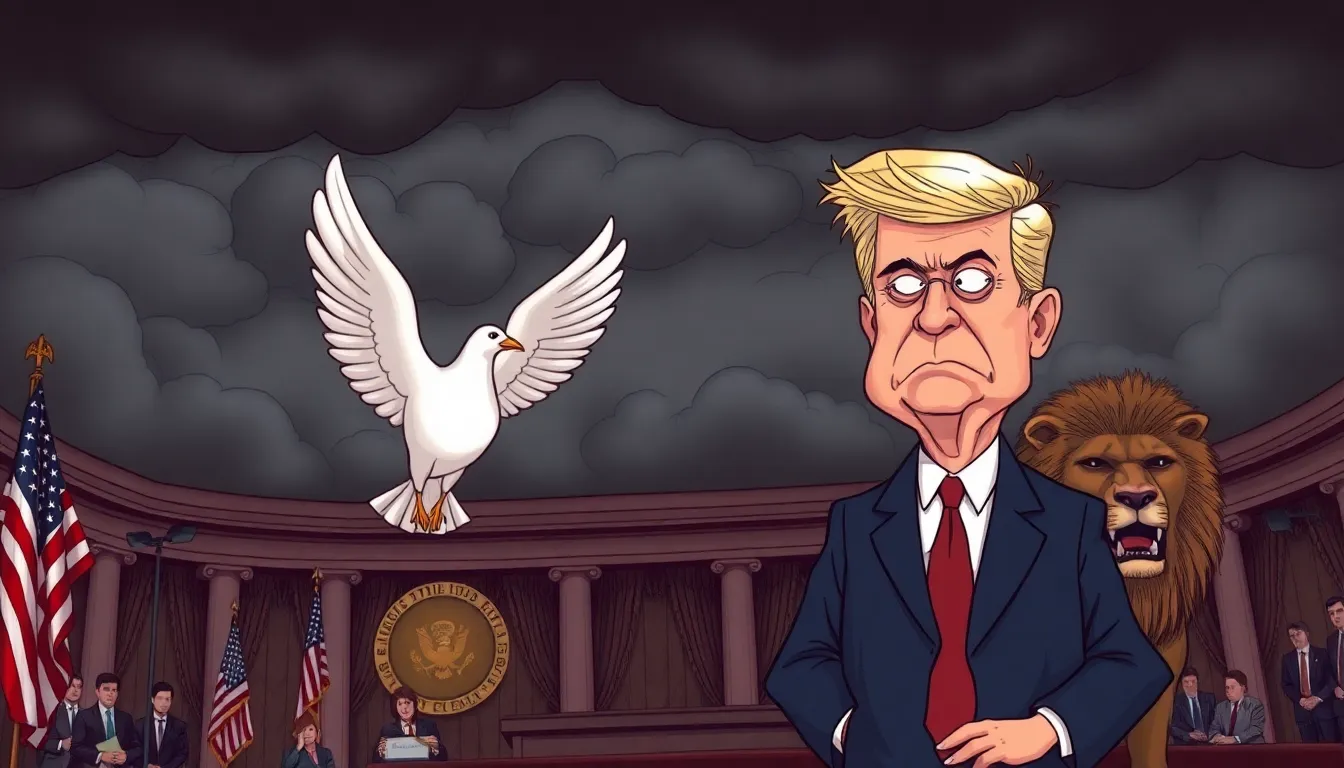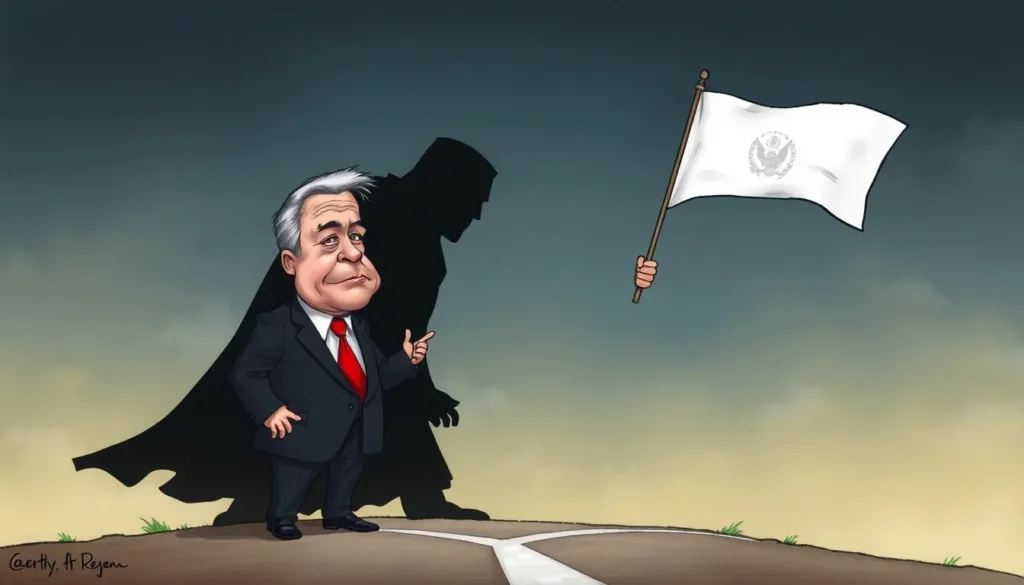Political cartoons have a knack for turning complex issues into digestible bites of humor. The “appeasement” political cartoon is no exception. With a clever mix of satire and visual wit, it captures the essence of political maneuvering in a way that’s both enlightening and entertaining.
Imagine a world where leaders try to pacify aggressors with a smile and a cupcake. Sounds absurd, right? Yet, this cartoon brilliantly highlights the folly of appeasement in a light-hearted manner. As it pokes fun at historical blunders, it invites viewers to reflect on the serious implications of such strategies. Dive into the world of political cartoons that not only make you chuckle but also spark important conversations about power, diplomacy, and the consequences of inaction.
Table of Contents
ToggleUnderstanding Appeasement Political Cartoons
Political cartoons on appeasement serve as powerful tools for critique and reflection. Through their satirical nature, they provoke deeper thought about the implications of placating aggressive powers.
Definition of Appeasement
Appeasement refers to a diplomatic strategy aimed at avoiding conflict by making concessions to an adversary. This approach often involves granting demands in hopes of maintaining peace. It gained prominence in the context of global politics, especially in the lead-up to World War II. The term is closely associated with Neville Chamberlain’s policies toward Adolf Hitler. Critics argue it emboldens aggressors, undermining long-term stability.
Historical Context of Appeasement
The historical backdrop of appeasement is critical for understanding its implications. In the 1930s, European leaders sought to prevent another devastating war following World War I. They aimed for peace by conceding to Germany’s expansionist ambitions. Events such as the Munich Agreement of 1938 exemplify this strategy. Leaders like Chamberlain believed they could secure peace through negotiation rather than confrontation. This ultimately failed, as their attempts to placate Hitler only intensified his aggression.
Analyzing Key Themes

Political cartoons effectively convey complex themes through visual storytelling. They engage audiences while encouraging reflection on significant issues like appeasement.
Visual Elements in Political Cartoons
Color choices play a pivotal role in illustrating emotions and highlighting important distinctions. For example, stark contrasts may symbolize conflict, while muted tones suggest resignation. Characters often embody exaggerated features, emphasizing their roles in political narratives. Settings within the cartoons frequently reflect historical moments, grounding the satire. The strategic use of composition draws viewers’ attention to critical elements, underscoring the message. Such visual techniques enhance understanding, making the cartoon’s critique of appeasement clear and impactful.
Common Symbols and Metaphors
Common symbols often recur in political cartoons discussing appeasement. The dove typically signifies peace or fragility, while a lion or wolf might represent aggressors. Chains might depict restraint, illustrating the consequences of unchallenged aggression. An open palm can symbolize concession or vulnerability. Metaphors materialize through imagery, such as a scale representing balance between peace and security. These devices enhance viewers’ comprehension of the underlying themes, inviting deeper analysis of diplomatic strategies and their implications.
Famous Appeasement Political Cartoons
Political cartoons often capture the essence of historical events, especially regarding appeasement. Several notable pieces illustrate the tension between diplomacy and aggression.
Notable Artists and Their Works
Prominent artists influenced the portrayal of appeasement in political cartoons. David Low became famous for his powerful commentary on Hitler’s rise and the folly of appeasement policies. His cartoon, “The Drunkard’s Progress,” starkly reflects the consequences of indulgence in appeasement. Another influential artist was Jim Borgman, whose sharp wit highlighted the absurdity of capitulating to aggressive powers. Such works remain crucial in understanding political strategies and evoking public response.
Impact on Public Perception
Appeasement political cartoons significantly shaped public perception of diplomacy. These illustrations prompted skepticism regarding leaders’ decisions to yield to threats. Audiences often connected visually with the satire, drawing critical conclusions about the failure of appeasement strategies. By highlighting the absurdities of compromise, these cartoons spurred discussions on the responsibilities of leadership. As a result, public sentiment evolved, recognizing the dangers of inaction in the face of aggression.
The Role of Political Cartoons in History
Political cartoons serve as powerful tools that shape public opinion and critique government actions. Their visual nature conveys messages quickly, making complex political issues more accessible.
Influence on Political Discourse
Political cartoons significantly influence political discourse by framing conversations around key issues. They often highlight critical moments and challenges, encouraging public debate and engagement. Visual satire prompts discussions about leadership and accountability, pushing audiences to question established narratives. Through humor and exaggerated imagery, they distill intricate themes into impactful visuals, effectively capturing the essence of political sentiments. The combination of wit and insight in these cartoons fosters a dynamic dialogue on relevant issues, prompting communities to reflect on their leaders’ actions and the implications of appeasement policies.
Reflection of Societal Attitudes
Societal attitudes find expression through political cartoons, revealing public sentiment towards leaders and policies. Cartoons often mirror the hopes and frustrations of communities during significant historical events. They encapsulate collective emotions, whether it’s fear of conflict or optimism for peace, addressing the impact of major decisions. Artists employ recognizable symbols and metaphors to connect with their audience’s feelings, capturing the zeitgeist of an era. By reflecting the mood of the populace, political cartoons not only comment on current events but also influence how society perceives historical narratives, particularly regarding contentious topics like appeasement.
Political cartoons serve as a powerful medium for critiquing complex issues like appeasement. By using humor and satire, they effectively highlight the folly of conceding to aggressors. The visual storytelling in these cartoons not only entertains but also encourages audiences to engage in meaningful discussions about the consequences of diplomatic strategies.
As history has shown, attempts to placate aggressive powers often lead to greater conflict rather than peace. The legacy of appeasement remains a critical lesson for contemporary leaders. Political cartoons continue to play an essential role in shaping public opinion and fostering dialogue around significant political themes. Their ability to distill complex ideas into striking visuals ensures they remain relevant in discussions about power, diplomacy, and the responsibilities of leadership.





